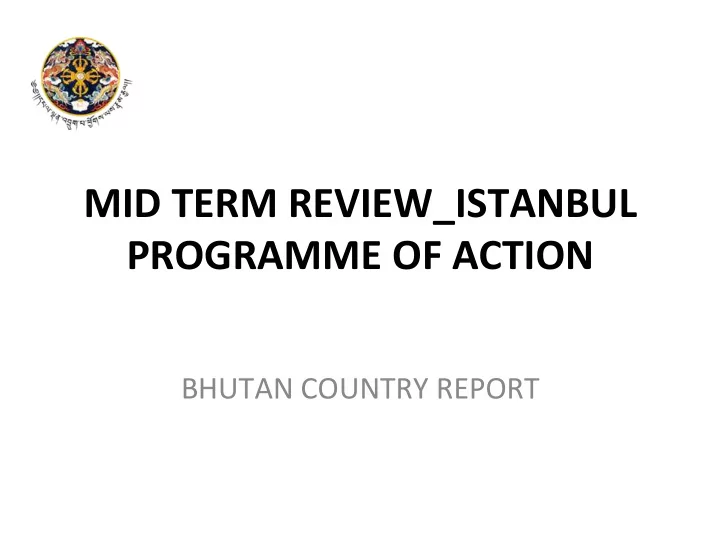

MID TERM REVIEW_ISTANBUL PROGRAMME OF ACTION BHUTAN COUNTRY REPORT
INTRODUCTION • Small landlocked LDC in the Himalayas • PopulaAon of 768,000 • Modern development started in 1962 • People centred approach to development- ‘ Development with Values’ • ConsAtuAonal democraAc governance structure • Current 11 th Plan – 2 nd plan under a democraAc government
Development elopment Plan lan Strategic gic Framew amewor ork k Maximiz aximization ion of of Gr Gros oss Na National ional Ha Happines ppiness Eleventh Plan Goal : Self-reliance and Inclusive Green Socio-Economic Development NaAonal Level 16 National Key Result Areas(NKRAs) & Key Performance Indicators (KPIs) Sector 150 Sector Key Result Areas(SKRAs) & Key Performance Indicators (KPIs) Level Agency Result Based Programs Level 3
Progress under the Eight Priority Areas • First Ame ever, Bhutan found eligible for graduaAon from the LDC category based on GNI per capita and HAI criteria • Economic growth rate over the 4 years (2011-2015) recorded at 6.46 percent • GDP per capita- USD 2612 in 2014 • MulAdimensional poverty reduced to 12.6 percent in 2012 • Income poverty reduced from 23% in 2007 to 12 percent in 2012 • Bhutan is on track in terms of achieving the MDG targets
Policy Enablers in place • Economic Development Policy, 2010 • FDI Policy, revised in 2010 • Renewable Energy Policy, 2013 • Food and NutriAon Security Policy, 2014 • Licensing Policy, 2015 • NaAonal Health Policy, 2012 • NaAonal PopulaAon Policy, 2013 • Enterprise RegistraAon Bill, 2015 • Social ProtecAon Policy, 2015 and Public Private Partnership Policy under discussion
Major Programme IntervenJon • Mainly guided by the 11 th FYP • Poverty ReducAon IntervenAons and Agriculture Development: – Rural Economy Advancement Programme (REAP) – NaAonal RehabilitaAon Programme – Targeted Household Poverty Programme – Agriculture produce diversificaAon – Sectoral AdaptaAon Plan of AcAon adopted for Climate Smart Agriculture • Energy Security – Development of 10,000MW hydropower projects – Rural ElectrificaAon – AlternaAve sources of renewable energy programmes
• Transport and CommunicaAons – Development of ICT infrastructures such as fibre opAc, IT Park – Development of SEZs, Industrial Parks • Private sector Development – Economic SAmulus Plan – FormaAon of Becer Business Council as a catalyst between public and private dialogue – Tax Holidays and tax exempAon on selected commodiAes • Efforts to reducing vulnerabiliAes to mulAple crises – ConsAtuAon mandates atleast 60 % of the total land area shall be maintained as forests – ImplementaAon of NAPA and NAMA – Early warning system and disaster relief fund insAtuted to improve disaster resilience and management – Electric Vehicle IniAaAve
Resource MobilizaJon • DomesAc resource mobilizaAon given highest priority • Efforts to mobilize resources internally – Broadening of tax base (Green tax and sales tax on vehicles and fuels) – Containing effecAve use of recurrent expenditures (cost cuhng measures) – Enhancing efficiency of state owned enterprises – Other financial instruments like bonds • Globally, exploring assistance from non- tradiAonal DPs such as GCF
Good Governance • One of the four pillars of GNH • Government Performance Management System insAtuted to enhance accountability and performance • Signing of Annual Performance Agreement between PM and respecAve agencies • Government to CiAzen Services (G2C) iniAated to increase efficiency and transparency of public service delivery through use of ICT • AnA-CorrupAon Commission established as consAtuAonal body to eliminate corrupAon
Coherence and linkages with Post-2015 Development Agenda and other Global Processes • SDG Rapid Integrated Policy Assessment by UNDP found 134 targets of the 143 relevant for Bhutan fully aligned with our Key Result areas in our 11 th FYP • As a early mover country in the Asia Pacific region efforts are already underway to further integraAon – SDG high level sensiAzaAon workshop on 30 th October – NaAonal workshop on LDC graduaAon: processes and implicaAons for Bhutan was held on 17 and 18 November
Challenges • Economic diversificaAon a criAcal strategy as country dependent on one parAcular sector making the economy vulnerable to external and internal shocks • Poverty sAll an issue- especially reaching the last mile • Export dominated by few products- agriculture accounts for only 5% of our exports • High volaAlity in agriculture producAon of crops and livestocks • Slow private sector growth • Supply side constraints due to low economies of scale and difficulty in mass producAon • Lack of resources- both financial and human resources
Challenges • Climate change, related environment issues and disasters sAll remain a challenge • Youth unemployment and youth related issues such as drug abuse • MeeAng EVI under the LDC graduaAon criteria can pose major challenge to the country
Strategies for GraduaJon • Development of long term strategy for Bhutan outlining the potenAal role of regional and global markets in Bhutan’s development • Explore insurance mechanisms to address the mulAfaceted vulnerabiliAes • Involvement of all stakeholders in the implementaAon process • Development of a domesAc manufacturing base • Developing an Industrial Policy
Way Forward • 11 th Plan Mid Term Review ongoing to assess the progress and further integraAon • The dral 12 th Plan guideline is being developed providing good opportunity and plamorm to integrate naAonal prioriAes and internaAonal development goals into our naAonal development planning framework • Secure addiAonal investments to sustain progress by building producAve capaciAes for structural economic transformaAon • OperaAonalise commitments made to LDCs in 2030 Agenda, AAAA and IPOA
THANK YOU
Recommend
More recommend